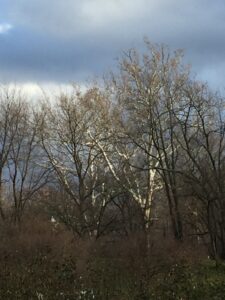“Woof woof!” “Bow wow!” “Yip yap!” “Arf arf!” Winter…the time of year when trees have lost their leaves. Sounds carry when the landscape is snow free. As a result, dog owners may be able to identify their furry friends from the sound of their bark. At the same time, sight lines change and can suddenly become revealing. Nature enthusiasts may be able to identify a distant tree from the appearance of its bark.
Peeling, smooth, ridged, furrowed… These are just some of the many textures of tree bark. Tree bark also develops different characteristics such as color and thickness. In addition, the bark of a juvenile tree can differ from the bark of a mature tree of the same species. A mature sycamore tree, for example, with its smooth and nearly white bark, makes it a stand out in the winter landscape. 
Tree bark is formed when the outer phloem layer dies and becomes cork-like. The phloem layer is also part of the inner bark of the tree. It transports sugars, produced through photosynthesis in the leaf, from the crown of the tree to the roots where carbohydrates are stored. The phloem layer is renewed over and over by the cambium layer during the life of the tree. Outer bark is the important protective layer on trees. It creates a barrier to the outside environment protecting the tree from wind, sun, temperature changes and a multitude of pests.
Winter is a wonderful time of year to look around and notice the beauty as well as the many differences displayed in the outer layer of trees…bark, bark!
Written by Stephanie Williams
